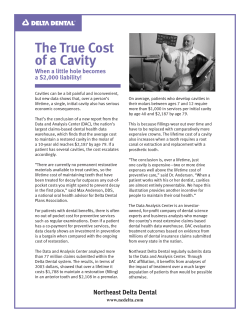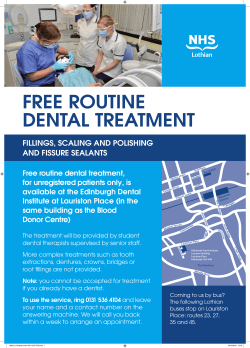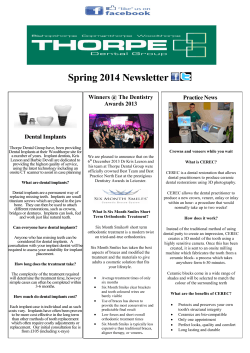
How to Perform a Buccal Approach for Different Dental Procedures
DENTISTRY—“HOW-TO” AND SELECTED TOPICS How to Perform a Buccal Approach for Different Dental Procedures Manfred Stoll, DVM Author’s address: Bleidenstadter Weg Manfred_Stoll@T-online.de © 2007 AAEP. 1. Introduction Limited space and limited visibility in the oral cavity pose problems in the approach to almost all dental procedures. It is usually necessary to use mirrors and dental instruments simultaneously during these procedures. The buccal approach allows for the use of instruments and endoscopical optics through a hole in the cheek. The use of straight instruments provides better movement of instruments and application of increased force on the tips of the instruments. The buccal approach may be used in the standing horse or lateral recumbency. 2. Materials and Methods Procedure The buccal approach can be performed in the sedated horse with local anesthesia or if necessary, with general anesthesia. Routinely, an IV catheter is placed, and detomidinea (0.01– 0.02 mg/kg body weight [BW], IV) is used for sedation. After this initial dose, the horse can be connected to a detomidine drip (60 mg detomidine and 1000 ml saline) at 1 drop/s, depending on effect. To increase the analgetic effect of the sedation and possibly slow tongue movement, butorphanolb (1 mg/100 kg BW, IV) can be added. If there is still too much tongue movement, diazepam (1 mg/100 kg BW, IV) can be 7, D-65329 Hohenstein, Germany; e-mail: given as well. Beside the relaxation of the tongue, the whole horse becomes more relaxed and atactic. This drug combination should be used carefully and preferably in stocks. The duration of the effect of diazepam is short, lasting ⬃10 –15 min. To desensitize the mucous membranes of the mouth, one can spray lidocaine into the oral cavity. This often makes the horse more tolerant to oral manipulation. On the side where the buccal approach will be performed, the skin of the cheek is clipped, shaved, and aseptically prepared. After shaving, it is very important to identify the facial nerves and the facial artery and vein. In horses with thin skin, these structures are easy to find. If the nerves and vessels are not visible, one can try to palpate them. To prevent damaging these sensitive structures, it is helpful, to mark their position with a pen (Fig. 1). To desensitize the skin and the muscles of the cheek, 5 ml of 2% lidocaine are injected subcutaneously, and 5 ml are infiltrated into the deeper tissue of the incision area (Fig. 2). After 10 min, the incision can be made with a scalpel and enlarged with Metzenbaum scissors.c To target the spot for the approach, a mouth speculum is used, and the spot is marked from the oral cavity through the cheek with a fingertip or a needle. To have full access to the cheek, a Gu¨nther speculumc is used, and the head is NOTES AAEP PROCEEDINGS Ⲑ Vol. 53 Ⲑ 2007 507 DENTISTRY—“HOW-TO” AND SELECTED TOPICS Fig. 1. (a) Dorsal and (b) ventral buccal branches of the facial nerve, (c) facial artery and vein. Fig. 3. supported on a head-support stand. The incision is made vertically between the dorsal and the ventral buccal branches of the facial nerve (Fig. 3). Depending on the affected area, the incision can be made either rostral or caudal to the facial artery. The size of the incision depends on the instruments desired to be used through the opening. After the dental procedure is finished, the incision is closed by simple interrupted sutures or interrupted mattress sutures. Because the incision is usually small and deep, the muscle layer and the skin is sutured together in one layer. After suturing the muscle and skin, the wound is inspected and palpated through the oral cavity. If one can still stick a fingertip into the buccal incision, the oral membrane and the muscle layer is adapted additionally through the oral cavity with one or two simple interrupted sutures. To prevent wound infection, the horse is kept on antibiotics for several days. After 10 –14 days, the sutures can be removed. Fig. 2. Local anesthesia of the incision area. 508 2007 Ⲑ Vol. 53 Ⲑ AAEP PROCEEDINGS Incision. Buccal Approach for Extractions Upper 8th, 9th, or even 10th cheek teeth with a fractured or missing crown can be a real challenge to loosen and extract orally.1–5 If the crown is broken to the gingival level, it is hardly possible to use a molar separator to loosen the tooth.6,7 It is possible to use 90° dental picks, but when one is operating deep in the mouth, it is hard to position them in between the teeth. Also, because of the limited range of the mouth, very little movement of the tip is achievable. The described buccal approach allows one to reach the tooth directly with a straight elevator (Fig. 4). To achieve an effect equal to a molar separator, straight dental picks or sharpened screwdrivers are pushed alternately into the interdentium rostral and caudal to the affected tooth after the gingiva around the tooth has been elevated. It is essential to sharpen the tips of the screwdrivers to position them into the interdental space, because there is minimal space present. It is very helpful to Fig. 4. Straight elevator through the buccal approach. DENTISTRY—“HOW-TO” AND SELECTED TOPICS Fig. 5. Screwdriver and flat spanner. have different sizes of screwdrivers available. The procedure is started with the smallest screwdriver. To push the screwdriver into the interdentium, a hammer is carefully used. To stretch the interdentium and to loosen the periodontal attachments, the instrument stays in place for 3–5 min. After a couple of shifts from rostral to caudal, it is possible to rotate the screwdriver with a flat spanner toward the affected tooth to place force directly towards the oral cavity (Fig. 5). As soon as the tooth gets looser, the next size screwdriver is used. In addition to the rostral and caudal use of the screwdrivers or dental elevators, it is sometimes necessary to insert the instruments alternately buccal and palatal to the affected tooth. Special care should be taken when operating palatally, because severe bleeding can occur when the palatal artery is lacerated. After an extended period of loosening, the tooth should start to move toward the oral cavity until it can be reached by a molar forceps. In some cases, the tooth becomes loose, but it is not possible to move it out of the alveolus. If there is no chance to reach the reserve crown with a forceps, a different way of pulling can be tried. A hole is drilled into the tooth through the buccal approach with a tungsten-carbide cutter on a hand piece or with a stone drill through a drill sleeve (Fig. 6).8 A Steinmann pin with a screw thread can then be fixed in the hole to pull the tooth (Figs. 7–9). A 6-mm hole is drilled for a 6.5-mm Steinmann pin, and a 4.5-mm hole is necessary for a 5-mm pin. The Steinmann pin is fixed in a chuck and carefully screwed into the hole in the tooth. Then, the pin is used to move and loosen the tooth in the alveolus. It is essential that the tooth be relatively loose before extraction. If there is movement present, extraction can be tried. A hammer is used to knock carefully onto the chuck on the Steinmann pin to pull the tooth with little strokes out of the alveolus. Fig. 6. Drilling into the reserve crown through a drill sleeve. Restorative Treatments The buccal approach is an effective way to gain good access to the crown of an infected 109 and/or 209 or the deep periodontal pockets in this area. After cleaning the mouth with a water pick, the buccal approach is performed as described in the preceding section. The hand piece is inserted through the buccal incision to drill out the carious material. To control the drilling, a mirror or an oral camera is placed in the oral cavity. It can be difficult to drill, because the view of the mirror is reversed left to right. It is much easier to watch the movement of the hand piece through an intraoral camerad or an endoscope, because the view is not inverted. After drilling is finished and the hole is flushed with water and air dried, the wall of the cavity is spread with phosphoric-acid gel. A syringe with phosphoricacid gel can be placed through the buccal incision, Fig. 7. Steinmann pin screwed into the reserve crown. AAEP PROCEEDINGS Ⲑ Vol. 53 Ⲑ 2007 509 DENTISTRY—“HOW-TO” AND SELECTED TOPICS tube is positioned or the cheek is lined with gauze. An alternative method is to use self-etching bonding agents that do not have to be washed out. For good adhesion of the composite, a special bonding agent is spread onto the wall of the hole. It is either light cured or it is chemically activated by a second component that is mixed together before use. The bonding fluid can be brought in with a brush or a syringe with a needle. The tip of the curing light can be positioned through the buccal approach; then, the hole is ready to be filled with composite. Chemically activated or light-curing composites are available. The advantage of chemically activated composite is minimal shrinking when polymerization occurs. The disadvantage of this composite is the short working time (1–1.5 min) available after mixing the two components. The light-curing composites can be applied through the buccal approach directly into the hole of the tooth and can be molded until the curing light is used. Because holes in equine teeth are sometimes very deep, the composite should be applied in several layers of 2–3 mm per layer. Oral Orthopedics Fig. 8. Steinmann pin in the chuck for loosening and pulling the reserve crown. In fracture treatment, it is often necessary to place wires between the cheek teeth.9 Intra-orally, it is quite challenging to position the wire. By drilling a hole between the cheek teeth through a buccal approach, it becomes much easier. To perform this procedure, a small skin incision is made, and a Steinmann pin with hand piece or power drill is used to drill a hole into the interdental space. While the Steinmann pin is pulled back, the wire is placed into the hole. 3. Fig. 9. Extracted reserve crown. and the gel is spread through a needle to the wall of the hole. The procedure has to be controlled by a dental mirror or an oral camera. The phosphoricacid gel is left in place for 30 – 40 s and then flushed out alternately with water and air. The flush is repeated a couple of times to ensure that the whole amount of gel is washed out. To protect the buccal incision from contamination, an intra-oral suction 510 2007 Ⲑ Vol. 53 Ⲑ AAEP PROCEEDINGS Discussion The buccal approach simplifies different dental procedures by allowing the use of straight instruments through the cheek. One of the most common situations in which this approach is used is a retained root fragment or a retained piece of the reserve crown. Access to the tooth is very direct and creates a lot of extra workspace beside the intra-oral cavity. It becomes easier to extract fractured cheek teeth and root fragments because of increased mobility and force on the tip of a straight elevator. Extraction of teeth using the buccal approach seems to be a promising way to remove teeth in good condition for reimplantation.e Treatments can be difficult to perform inside the mouth without the buccal approach, because long extensions for instruments are needed. The progress of dental treatments and surgeries is hard to anticipate, even if a thorough exam has been performed and high-quality radiographs have been taken. It is, therefore, very important to know alternative ways to perform dental procedures. If necessary, the buccal approach can be performed either in the field or in a clinic. DENTISTRY—“HOW-TO” AND SELECTED TOPICS 4. Risks and Complications The main risk of this procedure is the possibility of damaging the facial nerve, facial artery, or parotid duct. Even suturing the buccal incision can damage nerves or vessels. Therefore, anatomical orientation is very important to minimize the risk of injuring important structures. To avoid damaging the facial nerve, facial artery, or parotid duct, one should always mark these palpable structures with a waterproof pen (Figs. 1–3). This reminds one to keep distance to these structures during the whole procedure. Because of the local anesthesia of the cheek, a temporary facial-nerve paralysis is present a couple hours after surgery. This sometimes disables the horses to drink and eat for some hours, so it may be beneficial to keep them on IV fluids during or after the procedure. Moderate wound swelling with edema is commonly seen after surgery. To reduce swelling, phenylbutazonef (4.4 mg/kg BW, IV) can be given once daily. If one uses the buccal approach with care, complications are rare. References and Footnotes 1. Evans LH, Tate LP, LaDow CS. Extraction of the equine 4th upper premolar and 1st and 2nd upper molars through a lateral buccotomy, in Proceedings. Am Assoc Equine Pract 1981;27:299 –302. 2. Orsini PG. The oral cavity. In: Auer JA, Stix JA, eds. Equine surgery, 3rd ed. Philadelphia: W.B. Saunders Co., 2005;296 –305. 3. Kertesz P. Dental diseases and their treatment in captive wild animals. In: Kertesz P, ed. A colour atlas of veterinary dentistry and oral surgery. London: Wolf, 1993;215– 281. 4. Lane JG, Kertesz P. Equine dental surgery. In: Kertesz P, ed. A colour atlas of veterinary dentistry and oral surgery. London: Wolf, 1993;199 –214. 5. Tremaine WH, Lane JG. Exodontia. In: Baker GJ, Easley J, eds. Equine dentistry, 2nd ed. Edinburgh: Elsevier, 2005;267–294. 6. Hahn K, Ko¨hler L. Zur Oberkieferbackenzahn-Extraktion mit Knochenflap-Technik, Muskelplastik und Alveolarverschlu beim Pferd. Tiera¨rztliche Praxis 2002;30:39 – 45. 7. Lane JG. Equine dental extraction—repulsion vs. buccotomy: techniques and results, in Proceedings. 5th World Veterinary Dental Congress 1997;135–138. 8. Hackmann PG. Intraorale Extraktion eines Backenzahns mit abgebrochener klinischer Krone am stehenden Pferd. Der Praktische Tierarzt 2006;87:965–967. 9. Knox PR, Crabill MR, Honnas CM. Mandibular and maxillary fracture osteosynthesis. In: Baker GJ, Easley J, eds. Equine dentistry, 2nd ed. Edinburgh: Elsevier, 2005;313– 324. a Dormosedan, Pfizer GmbH, D-76032 Karlsruhe, Germany. Torbugesic, Fort Dodge Veterina¨r GmbH, D-52146 Wu¨rselen, Germany. c Metzenbaum scissors, H. Hauptner & Richard Herberholz GmbH & Co. KG, D-42651 Solingen, Germany. d LED-Dentalstick-Equine, Dr. Fritz GmbH, D–78532 Tuttlingen, Germany. e Jaugstetter H. Personal communication, 2007. f Phenylbutazone, Vetoquinol GmbH/Chassot GmbH, D-88212 Ravensburg, Germany. b AAEP PROCEEDINGS Ⲑ Vol. 53 Ⲑ 2007 511
© Copyright 2025

![[ PDF ] - journal of evidence based medicine and](http://cdn1.abcdocz.com/store/data/000659472_1-72430c9567757e71565dde719de90d86-250x500.png)








